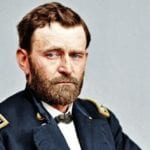 Mysteries
Mysteries  Mysteries
Mysteries  History
History 10 Surprising Stories About the Texas Rangers
 Humans
Humans 10 Philosophers Who Were Driven Mad by Their Own Theories
 Miscellaneous
Miscellaneous 10 Video-Game-Worthy Weapons and Armors from History
 Weird Stuff
Weird Stuff 10 Psychics Who Accurately Predicted Wartime Events
 The Arts
The Arts 10 Pieces of Art Inspired by a Broken Heart
 Health
Health 10 Science Fiction-Sounding New Medical Treatments
 History
History 10 Surprising Facts About the Father of Submarine Warfare
 Space
Space Ten Astonishing New Insights into Alien Worlds
 Weird Stuff
Weird Stuff 10 Bizarre Summer Solstice Rituals Still Practiced Today
 Mysteries
Mysteries Top 10 Haunting Facts About the Ghost Ship MV Alta
 History
History 10 Surprising Stories About the Texas Rangers
 Humans
Humans 10 Philosophers Who Were Driven Mad by Their Own Theories
Who's Behind Listverse?

Jamie Frater
Head Editor
Jamie founded Listverse due to an insatiable desire to share fascinating, obscure, and bizarre facts. He has been a guest speaker on numerous national radio and television stations and is a five time published author.
More About Us Miscellaneous
Miscellaneous 10 Video-Game-Worthy Weapons and Armors from History
 Weird Stuff
Weird Stuff 10 Psychics Who Accurately Predicted Wartime Events
 The Arts
The Arts 10 Pieces of Art Inspired by a Broken Heart
 Health
Health 10 Science Fiction-Sounding New Medical Treatments
 History
History 10 Surprising Facts About the Father of Submarine Warfare
 Space
Space Ten Astonishing New Insights into Alien Worlds
 Weird Stuff
Weird Stuff 10 Bizarre Summer Solstice Rituals Still Practiced Today
Ten Presidential Illnesses and Their Consequences
Any discussion about presidential illnesses inevitably involves America’s favorite fatal footnote. On the 48-degree morning of March 4, 1841, William Henry Harrison—at 68, the oldest president the young nation had elected up to that point—gave what remains the longest presidential inaugural address in American history. To show his vitality, he refused a coat, top hat, or gloves. Exactly one month later, he died from pneumonia.
But while tragic, Harrison’s ailment didn’t really affect the public or the presidency itself; his tenure was simply too brief. Following are more impactful presidential maladies, in chronological order.
Related: Top 10 Costly US Presidential Campaign Blunders
10 George Washington: No Teeth? No Thanks
This list’s oddest malady may have contributed mightily in shaping not only one president’s tenure but the norms of the office after that.
Poor dental health can instigate myriad detrimental issues throughout the body. For example, uncontrolled mouth bacteria can multiply and enter the bloodstream, fomenting infections in unassociated organs. Gum disease, in particular, is linked to heart disease, diabetes, and respiratory trouble, among other conditions.
The mouth is a gateway to the body. And George Washington’s mouth was a dental disaster area. Two centuries before fluoride toothpaste, Washington lost his first tooth to decay in 1756 at age 24. Several more were extracted in the ensuing decade.
By age 40, one telling correspondence thanks a friend for “two large stone jars of pickled tripe,” gifted for their softness. In 1776, a portrait of then-General Washington shows a scarred left cheek from surgery for abscessed teeth. By the time he became president in 1789, one tooth remained. By 1796, his final full year in office, he had none.
The pain and suffering Washington’s teeth caused almost certainly factored into his longevity. At 57, he reluctantly accepted the presidency; at 61, he had to be begged to serve another term. By 65, forget it.
Washington could have served for life but instead set the presidential precedent, eventually codified, of two consecutive terms. His decision was vindicated when he died two years later of a severe throat infection—an organ suspiciously close to his toothless mouth.[1]
9 Alcohol Abuse: Two out of Three Ain’t Good
Two out of three ain’t bad… unless you’re referring to presidents being drunkards. And in the 1850s—the crucial decade preceding the Civil War—two high-leverage administrations were marred and muted by their incessantly inebriated chief executives.
Let’s start with Franklin Pierce, whose presidency frequently ranks among the worst in American history. A one-minute video summarizing his tenure literally begins with “Franklin Pierce, the 14th President, was a handsome lawyer who liked social events and alcohol.” Not the best start, Frankie. Pierce fomented slavery-centric bloodshed in Kansas, vetoed social safety bills, and failed to win even his party’s nomination for a second term. Upon exiting, he famously declared, “There’s nothing left to do but get drunk.” Well played, sir.
But the good times kept rollin’ at the White House. Next up was James Buchanan, whose daily intake included no less than two full bottles of cognac and rye whiskey. According to contemporary Washington D.C. liquor merchant Jacob Baer—who was, unsurprisingly, friendly with the president—Buchanan went through ten GALLONS of whiskey per week.
With the exception of a particularly drunken stretch that may have hindered troop directions during the 1857-58 anti-Mormon Utah War, Buchanan rarely seemed to show ill effects from his excessive alcohol intake. However, the overarching concern with both Pierce and Buchanan is their impotence at a tenuous time that called for inspired leadership. Neither was capable of providing the steady, sober stewardship the divided nation needed.[2]
8 Abraham Lincoln: Sad, But True
In January 1841, Abraham Lincoln was a 31-year-old Illinois legislator whose career was hindered by a state debt crisis. That winter was frigid, exacerbating what Lincoln called his “defective nerves.”
“Lincoln went crazy,” reported his close friend, Joshua Speed. “I had to remove razors from his room—take away all knives…” It was the second time Lincoln’s friends stood suicide watch; the first followed the death of a friend (and rumored lover) Ann Rutledge.
Lincoln was predisposed to such despondence. According to biographer Joshua Shenk, both Lincoln’s mother’s deep, pervasive sadness and his father’s spells of self-isolation showcase this. And while diagnosis from afar (or through the ages) is imperfect, Lincoln’s background and behavior meet the criteria for depression per the Diagnostic and Statistical Manual of Mental Disorders.
Per researcher Rich Barlow, Lincoln’s two depression-combatting weapons first helped make him president—then helped make him perhaps the greatest of all presidents. One was ambition, which left Lincoln striving for a hopeful horizon rather than dwelling on a compromised present. The second was seeking the esteem of fellow men—a substitute for his disease-driven lack of self-esteem.
“I have no other [desire] so great,” Lincoln once declared, “as that of being truly esteemed by my fellow men, by rendering myself worthy of their esteem.” Barlow argues that Lincoln’s need for validation also included ensuing generations, strengthening his antislavery leanings, and cementing his commitment to codifying abolition through his signature political achievement: passage of the slavery-banning 13th Amendment.[3]
7 Grover Cleveland’s Cancer: Don’t Panic
In June 1893, Grover Cleveland had two big problems. After initially holding the position from 1885-1889, he’d recently become the only U.S. president elected to two non-consecutive terms. But so far, the sequel sucked. Two months after his inauguration, a global run on gold sparked the Panic of 1893. The subsequent bank runs and credit freezes ignited a full-blown economic depression, with unemployment soaring to nearly 20%.
Starting with repealing the 1890 Sherman Silver Purchase Act, which exacerbated inflation, Grover Cleveland had a plan. Unfortunately, he also had cancer; specifically, the cigar-smoking commander-in-chief had a rough, quarter-sized lesion on the roof of his mouth.
While all presidents understandably guard their medical histories, what ensued was an incredibly high-stakes game of surgical secrecy. Cleveland was due to address Congress in early August. He did not want the already-panicked public to quake markets further upon learning of his serious illness. So he did this…
He had cancer surgery on a yacht. Like a boat yacht—one with, like, waves and stuff. Not kidding.
It gets crazier. Upon making their initial incisions, surgeons discovered a tumor far larger than expected and pervasive enough that they had to remove much of Cleveland’s left upper jaw. Aided mightily by a scar-hiding mustache, Cleveland recovered enough to address Congress on August 6. When the clandestine surgery was finally exposed in 1917, it became one of several impetuses for better defining the circumstantial and temporary transfer of presidential powers.[4]
6 William Howard Taft: Huge Problems
At 5 feet 11 inches (180 cm) and a maximum weight of 335 pounds (152 kg), William Howard Taft was obese. And as president, his unhealthy size led to more setbacks than allegedly getting stuck in a White House bathtub—an indignity that, fortunately for the 27th president, likely never actually happened.
To his credit, Taft tried valiantly to trim down. Concerned about his longevity and humiliated by exaggerated political cartoons, he consulted with nutritionists and attempted low-fat, low-calorie diets well ahead of his time. Still, the big-boned bloke could never get under 250 pounds (113 kg) and would bulge back up when his discipline waned.
Heart disease, stroke, diabetes, certain cancers—Taft’s weight made him significantly more susceptible to developing each. But during his lone term in office, which spanned 1909-13, the obesity-associated issue that most affected Taft was sleep apnea.
This was no small issue. Officially called obstructive sleep apnea, the condition meant more than extra coffee and a little yawning. The nation’s chief executive frequently dozed off during the daytime, reportedly even snoring during high-leverage meetings. Publicly, he nodded off in church, at the theater, and even at a funeral. Privately, he fell asleep signing documents.
Many found Taft atypically antisocial at times, and sleep deprivation likely exacerbated his most oft-noted weakness: indecision. After four years, the nation was tired of tired ol’ Taft. The Fat Lady sang when he finished third behind Woodrow Wilson and Teddy Roosevelt, Taft’s mentor-turned-antagonist.[5]
5 Woodrow Wilson’s Stroke: The First Female President?
In 1919, Woodrow Wilson had his sights on something unprecedented: a third consecutive presidential term. Following victory in the First World War and a trip abroad to launch the UN-precursor League of Nations, he embarked on a cross-country tour to sell the public on the alliance.
Unfortunately, the 62-year-old’s body couldn’t keep up. On September 26, his wife Edith noticed his facial muscles twitch and droop. The remainder of the tour was canceled. Back at the White House, on October 2, Wilson collapsed in the residence. The president’s physician, Dr. Cary Grayson, soon arrived—and was horrified. “My God,” he exclaimed, “the president is paralyzed.”
Edith’s uber-protective reaction culminated in her becoming who some historians consider America’s first female chief executive. Her husband, bedridden and without at least some (and possibly most) of his faculties, Edith secluded Woodrow from virtually all visitors—including his cabinet and members of Congress. When a bedside meeting was unavoidable, Edith kept Woodrow’s limp left side covered by blankets.
Before 1967, no formal process existed transferring power to the vice president in the event of debilitating illness. This allowed the secretive First Lady to become de facto president—assuming the responsibilities of an office she, as a woman, couldn’t even vote for yet. It’s widely believed Edith, who screened paperwork as well as callers, even signed her husband’s name to documents without consulting him. Incredibly, the extent of Wilson’s illness—and his wife’s substitute stewardship—were kept largely under wraps until he left office in early 1921.[6]
4 FDR’s Polio, Part 1: A Political Blessing
Throughout Franklin Delano Roosevelt’s 12-plus years in office, he downplayed his polio. Public appearances were carefully orchestrated, with FDR leaning on lecterns or seated in chairs or cars. When walking was unavoidable, aides flanked him to bear the load.
This created a false narrative that portrayed the public as unaware of FDR’s disability. But according to James Tobin, author of The Man He Became, this wasn’t the case: “Go back to the newspapers of the time, especially from the 1920s when Roosevelt was making his political comeback,” Tobin told National Public Radio, “and his disability was discussed constantly… So there’s no question that people knew about it.”
In fact, Tobin sees FDR’s polio as steeling his will to succeed. By the time Roosevelt contracted polio, at 39, he’d already been a candidate for vice president. But when his 1920 Democratic Party ticket was defeated in a landslide, FDR’s political career was adrift.
Soon, polio would provide the ultimate test—a challenge so daunting that it made other goals comparably less intimidating. Further, FDR noticed his sudden and stark physical limitations left others uncomfortable. Per Tobin:
“Roosevelt realized that… people don’t know what to say, they don’t know where to look, they don’t know how to treat you, they don’t know whether to feel pity for you.” FDR learned to persuade people to feel at ease in his presence—skills he employed to become first New York governor in 1928, then president in 1932.[7]
3 FDR’s Polio, Part 2: A Geopolitical Curse
Unfortunately, while FDR’s perseverance over polio made him iron-willed, the flip side was a level of reality-denying obstinance. Regardless of Roosevelt’s extraordinary determination and impressive achievements—he is arguably the greatest president of the 20th century—polio is a debilitating, progressive disease.
By 1940, FDR had a decision to make. He’d had polio for nearly two decades and was visibly diminished from the man who’d become president eight years earlier. But with World War II raging and America drawing ever closer to direct engagement, FDR surmised he was the man for the job. Most would agree it was the right call.
But by 1944, FDR was simply too sick to serve a fourth term, which he died less than three months into. Crucially, this period included the February 1945 Yalta Conference, where the U.S., UK, and USSR forged the post-WWII global landscape. Per the 2010 book FDR’s Deadly Secret, the president suffered frequent lapses of consciousness and, while in Yalta, may have had a brain hemorrhage.
The book claims Roosevelt’s fragile state led to unnecessarily generous concessions to Soviet leader Josef Stalin. In particular, co-authors Eric Fettmann and Steven Lomazow detail the West’s forfeiture to Soviet interests of Manchuria and the northern portion of the Korean Peninsula. Both regions would soon fall under authoritarian communist rule, restricting the freedoms of tens of millions and expanding the Soviet sphere for the ensuing half-century.[8]
2 JFK’s Chronic Back Pain: A Deadly Tradeoff
John F. Kennedy was always sick. He nearly died of scarlet fever as a child and battled digestive issues and urinary tract infections throughout his life. He also had Addison’s Disease, an adrenal gland defect that can be fatal. Kennedy took corticosteroids to treat this illness.
These steroids likely exacerbated a preexisting condition: excruciating back pain. In 1944, a year after surviving the sinking of his torpedo boat in WWII, he underwent the first of four largely ineffective back surgeries. To mitigate the pain, JFK wore a back-straightening brace frequently—including in Dallas on November 22, 1963.
Watching the Zapruder film, the oddest motion JFK makes isn’t the “back and to the left” head jerk made famous by Oliver Stone’s eponymous 1991 film. Rather, as he emerges from behind a street sign, Kennedy’s hands awkwardly clasp his neck, elbows up at either side. He’d been shot through the upper back and neck.
Such an impact should have thrown Kennedy violently forward, forcing him to slump over or collapse into his wife’s arms. Instead, the back brace did its job: It kept Kennedy upright to receive the fatal headshot seconds later.
Dr. Kenneth Salyer, a 27-year-old resident at Dallas’s Parkland Hospital when Kennedy was rushed in, concurs. “He’s still upright as a target,” Salyer said in 2013, “because he has the brace on, which makes it possible for Lee Harvey Oswald to hit him with a second shot.”[9]
1 Richard Nixon’s Paranoia: A President’s Self-destruction
Before the comment thread fills with accusations of political bias, it is this writer’s opinion that Richard Nixon was a pretty good president. With the glaring exception of escalating the unwinnable Vietnam War, his record holds up well. It was the oft-maligned 37th president who ushered in the Environmental Protection Agency, opened relations with China, and significantly expanded access to affordable healthcare.
Also largely lost to history is Nixon’s remarkably high approval ratings. Campaigning for reelection in 1972, his approval approached 60%. He cruised to a landslide victory, carrying an incredible 49 states and 503 more Electoral College votes than his opponent, George McGovern.
The only thing that could stop Richard Nixon was… well, Richard Nixon. Emerging from humble beginnings and graduating from no-name Whittier College, he carried a massive inferiority complex. The 2000 biography Arrogance of Power includes interviews with his former psychiatrist, who believed Nixon suffered from depression and paranoia disorder. In 2008, previously unreleased White House recordings vividly showcase this, as Nixon warns staff that everyone—the press, academia, the establishment—is out to get him.
The consequences were nothing less than the most self-inflicted political wound in American history. Despite a cavernous polling lead over McGovern, in June 1972, Nixon had subordinates break into Democratic National Committee offices to dig for dirt. They got caught, and Nixon eventually designed in disgrace—all for looking for an edge he clearly didn’t need.[10]








